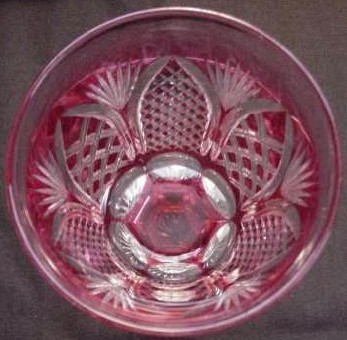
Wine glasses. c1840-c1860. LEFT: Solid yellow (lead glass containing uranium). Cut with nine flutes. Its stem, with a ball knop centrally placed, is solid (reflection in photo). Ground and polished pontil. H = 4.8" (12.4 cm), Sold for $70 in 1996. RIGHT: Solid green (bluish). Cut with seven flutes. Inverted baluster stem with air trap. Ground and polished pontil. Sold for $91 in 1996. Both of these wines were found together in a shop in Angelica, NY.

The following water goblet is an example of cut-glass tableware intended for the upper middle-class patron during the middle period. The cut portion on the bowl -- fine diamonds (cross-hatching) bordered with a row of small concave ovals (oblong bullseyes) -- is given the pattern-name "Lincoln band" by the writer in lieu of any known catalog name. It is the pattern that was cut on the set of tableware selected by the Lincolns for the White House in 1861 and re-ordered by their successors (Spillman 1989). The White House glasses have slightly differend shapes: Those goblets are less elongated, more cup-shaped. And the stems on the White House tableware are inverted balusters with air traps. Here the stem has the shape of a true baluster. It was formed by drawing out the gather that formed the glass's bowl, a type of stem that is sometimes called a "drop stem". Being solid, it lowers the center of gravity of the glass thus adding to its stability. The stem is cut with six flutes (panels). The foot has a 24-pt single star rather than the more elaborate "star-and-fan" design that is found on the White House stemware.
The engraving on the Lincoln set is elaborate and added greatly to its cost. In the present example the customer chose a much simpler border design and added an Old English letter H. The engraved border is similar to those found in the Leighton scrapbook which was in use at the New England Glass Works during the third quarter of the nineteenth century, but there is no exact match. The "Lincoln Band" cut-glass pattern closely resembles a pattern used during the 1820s on a tumbler of French manufacture (CMG acc. no. 50.3.12).
The writer found this goblet as part of a group of ten matching water goblets, clarets, and wines at a Jack Martone auction of a Bristol, RI estate that was held in North Providence on 11 Dec 1983. He purchased the lot of ten glasses for $60.50. The goblet shown here was subsequently purchased from the writer by the Corning Museum of Glass in 1986. The Museum has kindly permitted its photograph to be published.
Goblet. c.1860-c.1880. H = 6"H (15.2 cm), rim D = 3" (7.8 cm), foot D = 3.1" (8 cm) (Image: Corning Museum of Glass, acc. no. 86.4.93; image copyrighted, used with permission. This image may not be reproduced without the written permission of the Corning Museum of Glass.)

Set of four wine glasses. c1855-c1880. Wide flutes alternating with single, vertical miter cuts on their bowls. Two-part glasses. Dropped stems, flute cut, with flutes extending into base of bowl (see third photo). The flutes engraved with a vintage (grape) design. A monogram (L?) above the engraving in one panel of each glass. Star-cut feet. H = 4" (10.2 cm), rim D = 2" (5.1 cm). Sold at an eBay auction for $91 in 2004 (Images: Internet).



Sherry glasses, pair. c1865-c1880. Three-part glasses. Cut in the generic sharp-diamonds pattern on trumpet (conical) bowls. Faceted inverse-baluster stems with air traps. Note the increase in the thickness of the glass as the base of the trumpet-shaped bowl is approached. H = 4.5" (11.4 cm), rim D = 2.1" (5.3 cm). This pair of glasses sold for $102 at an eBay auction in 2002 (Image: Internet).

Wine glass. c1865-1880. Red cut-to-clear. Drop stem, fluted. Pattern similar to Fisher Diamond by Mt. Washington (c1885 catalog). H = 5.5" (14.0 cm), rim D = 3.9" (9.8 cm). (Image: Private Collection).


Goblet. c1860-c1880. An unknown pattern attributed to the Dorflinger Glass Company by the seller. Faceted waisted ("French") stem with air trap. Flashed star-cut foot. H = 6.5" (16.5 cm), rim D = 4.75" (11.9 cm). Sold at an eBay auction for $100 in 2006. (Image: Internet)

Updated 15 Jun 2007